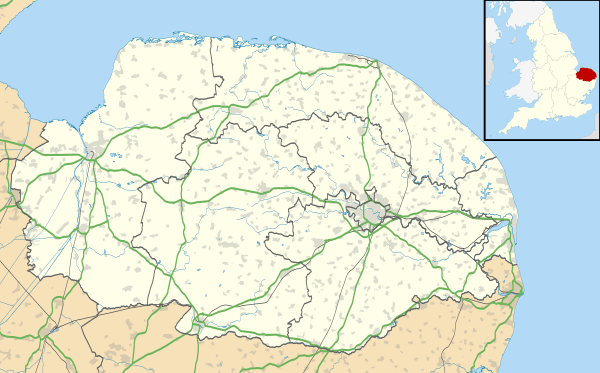RAF Foulsham
Royal Air Force Foulsham, more commonly known as RAF Foulsham[1] is a former Royal Air Force station, a military airfield, located 15 miles North-West of Norwich, in the English county of Norfolk, East Anglia, from 1942 to 1945.[2]
| RAF Foulsham | |||||||||||
|---|---|---|---|---|---|---|---|---|---|---|---|
| Norwich, Norfolk in England | |||||||||||
 RAF Foulsham Location In Norfolk | |||||||||||
| Coordinates | 52°48′06″N 001°00′23″E | ||||||||||
| Site information | |||||||||||
| Owner | Ministry of Defence | ||||||||||
| Operator | Royal Air Force | ||||||||||
| Controlled by | No. 100 Group RAF | ||||||||||
| Site history | |||||||||||
| Built | 1942 | ||||||||||
| In use | May 1942-1945 | ||||||||||
| Airfield information | |||||||||||
| |||||||||||
History
RAF Foulsham at Foulsham in Norfolk was built between 1941 and 1942 for No. 2 Group RAF Bomber Command and opened in May 1942 and declared operational on 26 June 1942. Foulsham was one of the few airfields to be fitted with FIDO in 1944, a fog dispersal system which used fires at the sides of the runways.
The airfield was equipped with three tarmac and woodchip runways and 37 hardstandings.[3] It also had 9 hangars, five of which were built for storing Airspeed Horsaglider aircraft ready for D Day.
The first residents were No. 98 Squadron RAF and No. 180 Squadron RAF, flying North American Mitchell bombers. The station was then used by No. 3 Group RAF who used Short Stirling and Avro Lancaster bombers. No. 514 Squadron RAF was formed at Foulsham, flying Lancasters.
The station then became the home of No. 192 Squadron RAF, which was part of No. 100 Group RAF, an electronic warfare unit which had its headquarters at Bylaugh Hall. 192 Squadron was later joined by another 100 Group squadron, No. 462 Squadron, Royal Australian Air Force, which operated Handley Page Halifax aircraft.
During World War II, 45 aircraft based at RAF Foulsham were lost. Many aircraft made emergency landings at Foulsham, including USAAF Boeing B-17 Flying Fortress F "Ruthie II", which made an emergency landing there in 1943 after an epic return flight for which co-pilot John C. Morgan was awarded the highest U.S. medal, the Medal of Honor. The airfield remained the property of the Ministry of Defence until the 1980s.
Foulsham aircraft
.jpg)
Several types of aircraft have operated out of Foulsham, among these:
Based units
- No. 12 Heavy Glider Maintenance Section[4]
- No. 16 Maintenance Unit RAF[4]
- No. 98 Squadron RAF[5]
- No. 99 Maintenance Unit RAF[4]
- No. 180 Squadron RAF[6]
- No. 192 Squadron RAF[4]
- No. 462 Squadron RAAF[4]
- No. 514 Squadron RAF[4]
- No. 1678 Heavy Conversion Unit RAF[4]
Current use
Currently, the runway is occupied by two large chicken houses and a photographic and film studio producing adult movies operates from the old fire station on the east side of the airfield.
See also
- Royal Air Force station
- List of former Royal Air Force stations
- List of Royal Air Force aircraft squadrons
References
- "RAF Foulsham". Details of the station. Airfields of Britain Conservation Trust. Retrieved 3 September 2014.
- Smith, Graham (2007). Norfolk Airfields in the Second World War. Section 12 – RAF Foulsham – Reference to location, usage and operational timeline. Countryside Books. p. 111. ISBN 9781853063206.
- "Foulsham - RAF Foulsham airfield". Reference to the runways, Number and construction material. Control Towers Co UK. Retrieved 3 September 2014.
- "Foulsham". Airfields of Britain Conservation Trust. Retrieved 11 April 2020.
- Flt.Lt. W.R. Lambert & Flt.Lt. R.A. Brown (August 1967). "A Short History of 98 Squadron". rafjever.org. Retrieved 3 September 2014.
- Jefford, C. G. (1988). RAF Squadrons: A Comprehensive Record of the Movement and Equipment of All RAF Squadrons and Their Antecedents Since 1912. Squadrons of the RAF – 108 Squadron (first ed.). Airlife Publishing Ltd. ISBN 9781853100536.
External links
| Wikimedia Commons has media related to RAF Foulsham. |
